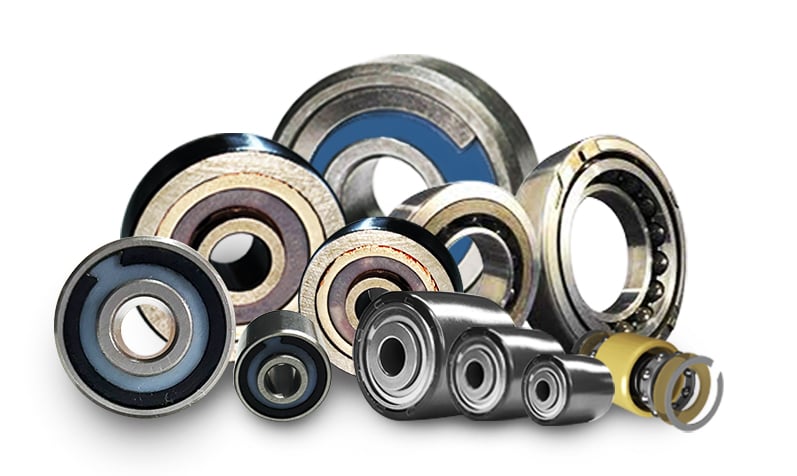Airframe Control Ball Bearings Vs Radial Ball Bearings in Aerospace
In the intricate realm of aerospace, ball bearings serve a pivotal role, ensuring precision, efficiency, and durability in various mechanical systems. The comparison of Airframe Control Ball Bearings Vs Radial Ball Bearings is more than a mere technical exercise; it underpins decisions crucial to the optimal performance and safety of aircraft components. Through this article, we will delve into the nuances of these bearings, shedding light on their distinct applications and the significance of their differences in the aerospace sector.

Understanding Ball Bearings in Aerospace
Ball Bearing Evolution in Aerospace
Ball bearings, originally devised for simpler machinery, have seen extensive refinement over the years, especially for aerospace applications. With the birth of aviation, the industry recognized the need for bearings that could withstand extreme conditions like varying altitudes, temperatures, and rapid speed changes.
Over time, as aircrafts became more complex and powerful, the ball bearings, such as airframe control ball bearings and radial ball bearings, evolved in tandem, incorporating advanced materials and engineering techniques to meet the specific demands of aerospace dynamics.
Significance of Precision, Durability, and Reliability
In the aerospace industry, the margin for error is minimal. The precision of ball bearings is paramount, ensuring seamless operations and avoiding costly, potentially dangerous mechanical failures.
Durability is equally critical, as bearings must withstand the rigors of repeated takeoffs, landings, and in-flight stresses.
Reliability ties these two attributes together; a reliable bearing functions precisely and durably under all conditions, ensuring the safety and efficiency of every flight.
In essence, the precision, durability, and reliability of ball bearings in aerospace underline the industry's unwavering commitment to safety and performance.
Airframe Control Ball Bearings: Spotlight on Specifications
Airframe control ball bearings are specialized bearings tailored for aircraft structures, particularly control systems and surfaces. Designed for low-speed oscillatory applications, they offer precision and support, effectively managing misalignments and flight-induced stresses.
- Purpose-Built Design: These bearings are of lightweight design, corrosion-resistant, grease-lubricated, and typically sealed, ensuring they handle shocks and vibrations inherent in dynamic flight conditions.
- Material Selection: These bearings utilize hardened AISI 52100 alloy, with all exposed surfaces, except bearing bore, caps and seals, plated for corrosion resistance. For superior protection, they can be made from AISI 440C stainless steel, optionally passivated or plated with cadmium or zinc nickel.
- Load Capacity: Given the crucial role they play in flight systems, these bearings are designed to handle varying and sometimes unpredictable load conditions. They need to sustain the stresses and strains of various flight maneuvers and conditions.
- Angular Alignment: Given the dynamic nature of flight, these bearings are often designed to accommodate slight angular misalignments without compromising performance.
- Specifications
“Standard” Series:DPP-W, B500 / MB500, KP-A / MKP-A, etc.
“Precision” series: MDW-K/MDW-, MKP-B, etc.
For further details on Airframe Control Ball Bearings, click here.
Aerospace Radial Ball Bearings: Delving into Details
Aerospace radial ball bearings are precision-engineered components designed to meet the specific demands of aerospace applications. Their primary function is to enable smooth rotation while managing loads, ensuring the reliability and efficiency of various aerospace equipment and systems.
Design Elements
- Varieties: Conrad-type, full complement, sealed/unsealed.
- Bore sizes: ranging from 3/16 inch to 6 inches.
- Precision: Grades ABEC 1 to ABEC 7.
- Customizations: Options for pre-loading, separators, shields, seals ,and lubrication.
Material Choices
- Standard Composition: SAE 52100 steel is commonly used for rings and balls, favored for its reliability and durability.
- Specialty Steels: RBC manufactures bearings from CRES 440C for enhanced corrosion resistance. They also offer options like “T8” rings and M50, BG42 rings for situations requiring high corrosion resistance or temperature resilience.
- Plating: A thin dense chrome (TDC) plating option is available, adhering to AMS 2438 standards. This plating ensures a bond that resists flaking or separation.
- Ball Materials: Beyond CRES 440C, they employ silicon nitride and M50 steel for specific conditions.
Performance Metrics
- Lubrication: Diverse lubricants cater to distinct aerospace needs, whether it’s high speed, water resistance, or high temperatures. Specialty lubricants like dry film are available for vacuum and space conditions.
- Adjustability: Diametral clearance can be adjusted, and pre-loads can be incorporated to fine-tune stiffness based on application requirements.
Head-to-Head: Airframe Control Ball Bearings Vs Radial Ball Bearings
For a quick, comprehensive comparison between Airframe Control Ball Bearings and Radial Ball Bearings, refer to our summary table below. It provides an at-a-glance understanding of their specifications, advantages, and potential challenges, allowing professionals to make informed decisions based on specific aerospace requirements.
|
Feature/Specification |
Airframe Control Ball Bearings |
Radial Ball Bearings |
|
Primary Application |
Aerospace flight control systems |
Broad range, including aerospace, automotive, and machinery |
|
Design |
Tailored for dynamic flight needs |
General-purpose design |
|
Material Choices |
Hardened bearing alloys (e.g., AISI 52100), with options for AISI 440C for enhanced corrosion resistance |
Predominantly SAE 52100 steel, but can vary depending on specific applications |
|
Corrosion Resistance |
Enhanced plating for aerospace conditions |
Standard resistance, with variations based on application needs |
|
Load Capacity |
High & variable for flight dynamics |
Standard to high, depending on design |
|
Weight Concerns |
Lightweight for aviation efficiency |
Weight varies; not always a primary concern |
|
Temperature Tolerance |
Wide range for aerospace conditions |
Standard range, with specialty designs for extremes |
|
Sealing and Lubrication |
Advanced seals, aerospace-specific lubrication |
General sealing, wide range of lubrication options |
|
Cost Implications |
Typically higher due to specialized design |
Generally more cost-effective but varies based on specifications |
|
Versatility |
Primarily aerospace-focused |
Wide-ranging applications |
|
Environmental/Sustainability Factors |
Engineered for minimal environmental impact in aerospace settings |
Standard design, with eco-friendly variations available |
Conclusion
Airframe Control Ball Bearings are tailored for aircraft dynamics, excelling in oscillatory settings, while Radial Ball Bearings are versatile, mainly handling radial loads. Selecting the right bearing is pivotal, reflecting both immediate requirements and long-term performance in aerospace applications. Make choices that align with enduring efficiency and reliability.
Keep Learning








